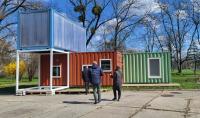The first urban aquaponic farm in Poland
Fresh, healthy and organically produced food right next to the house, and - on top of that - right in the city center – that is the main advantage of AquaFarm, which has opened in Wrocław. The undertaking was part of a Polish-Norwegian project in which the Warsaw University of Technology participates.
Aquaponics is a method of growing plants in water (hydroponics) and aquatic animals (aquaculture) within a single system. It is based on continuous water recirculation, obtained, among others, through the collection and treatment of rainwater. The valuable resource can be saved in this way. This method of cultivation also means that there is no need for soil or artificial fertilizers. The location of the farm just next to the residents also allows you to shorten the supply chain and reduce the carbon footprint. It is close and helps care for the environment.
The first Polish urban aquaponic farm takes up three food-ready sea containers and is equipped with tanks for breeding animals. For the time being, red-footed crayfish are floating here, but fish are also expected to appear. AquaFarma focuses on the cultivation of tribulus, mizuna, watercress, beef grass and leaf beet. Inside, there is space for activities for children, youth and adults, because the farm is not only to provide food, but it also plays an educational and social role. The farm is located in an urban environment, next to the historic water tower complex in Wrocław.
The urban and architectural side of the project is the responsibility of a team from the Faculty of Architecture of the Warsaw University of Technology: Paweł Pedrycz, PhD, and doctoral student Maria Jankowska, supported by Anna Cudny, PhD, and Łukasz Stępnik, MSc.
– Designing an aquaponic farm was a unique challenge for us, because in this way we set a new direction in the approach to food production in urban areas – says Paweł Pedrycz, PhD – This tangibly shows that the cultivation of edible plants and even animal husbandry in the city is possible and, moreover, it is not some hostile technological installation but a place that can become a local meeting point. This is a step towards more self-sufficient cities, which is particularly important in the climate crisis.
The Wrocław farm was created as part of the USAGE – Urban Stormwater Aquaponics Garden Environment project, financed by EEA and Norwegian Funds. A similar installation is located in Oslo. For the time being, it is a pilot project that is intended to assess whether such a solution works (in technological, social and economic terms).
The leader of the USAGE project is the Water Science and Technology Institute – H2O SciTech, and the consortium is also made up of the Norwegian Institute for Water Research, Warsaw University of Technology, Tadeusz Kościuszko, CASE – Centre for Socio-Economic Analysis, Fridtjof Nansen Foundation in Polhøgd.
More information about the farm and the USAGE project at aqfarm.eu.







